By Lambert Strether of Corrente.
As an engineering project, the James Webb Space Telescope (JWST) is, in fact, incredibly cool:
Being an exquisitely sensitive infrared astronomical observatory, the James Webb Space Telescope’s optics and scientific instruments need to be cold to suppress infrared background “noise.” Moreover, the detectors inside each scientific instrument, that convert infrared light signals into electrical signals for processing into images, need to be cold to work just right. Typically, the longer the wavelength of infrared light, the colder the detector needs to be to do this conversion while also limiting the generation of random “noise” electrons.
I totally identity with that; I have to suppress a lot of random “noise” electrons myself; it’s called the “news flow.” But why so cold?
The low temperature is necessary because all four of Webb’s instruments detect infrared light – wavelengths slightly longer than those that human eyes can see. Distant galaxies, stars hidden in cocoons of dust, and planets outside our solar system all emit infrared light. But so do other warm objects, including Webb’s own electronics and optics hardware. Cooling down the four instruments’ detectors and the surrounding hardware suppresses those infrared emissions. MIRI detects longer infrared wavelengths than the other three instruments, which means it needs to be even colder.
Another reason Webb’s detectors need to be cold is to suppress something called dark current, or electric current created by the vibration of atoms in the detectors themselves. Dark current mimics a true signal in the detectors, giving the false impression that they have been hit by light from an external source. Those false signals can drown out the real signals astronomers want to find. Since temperature is a measurement of how fast the atoms in the detector are vibrating, reducing the temperature means less vibration, which in turn means less dark current.
Yes, yes, “dark currents.” That tracks. Anyhow, the JWST has cooled down enough, and now that it has, we have photos! This is going to be an extremely lazy post, a mere excuse to post as many beautful JWST photos as I can find (hopefully different ones from the mainstream). Let’s go!
But wait. Let’s not.
I must also confess that I expected a JWST debacle; I well remember the day when the “mirror flaw” of the Hubble Telescope, another Pharonic project, was discovered: “[T]he observatory’s primary mirror had an aberration that affected the clarity of the telescope’s early images.” My first thought: “We can’t manufacture anything anymore.” A reasonably advanced thought for 1990, I think, and a thought that I and many others have had since. Fortunately, however, there was no JWST debacle, which really did give me some hope and confidence that the country wasn’t going to screw literally everything up. Here is a photo that shows what a glorious piece of machinery the JWST is (and by extension, the glory of its builders):
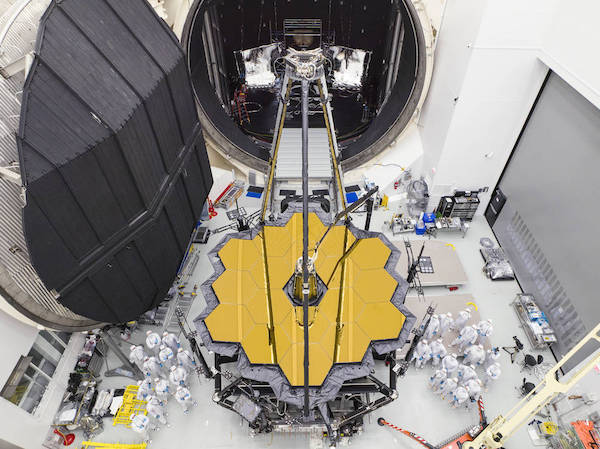
The link above gives a good description of the JWST instrumentation, but here is an explanation of how JWST’s iconic Primary Mirror, the golden hexagonalized construct seen at bottom center above, was engineered:
Webb Telescope’s scientists and engineers determined that a primary mirror 6.5 meters (21 feet 4 inches) across is what was needed to measure the light from these distant galaxies.
The Webb Telescope team also decided to build the mirror in segments on a structure which folds up, like the leaves of a drop-leaf table, so that it can fit into a rocket. The mirror would then unfold after launch. Each of the 18 hexagonal-shaped mirror segments is 1.32 meters (4.3 feet) in diameter, flat to flat.
The hexagonal shape allows for a roughly circular, segmented mirror with “high filling factor and six-fold symmetry.” High filling factor means the segments fit together without gaps. If the segments were circular, there would be gaps between them. Symmetry is good because there need only be 3 different optical prescriptions for 18 segments, 6 of each (see above right diagram). Finally, a roughly circular overall mirror shape is desired because that focuses the light into the most compact region on the detectors. A oval mirror, for example, would give images that are elongated in one direction. A square mirror would send a lot of the light out of the central region.
Gold improves the mirror’s reflection of infrared light.
(There’s a lot more information at the link above on the JWST’s mirrors.) If you’ve got four hours, here’s a video of the primary mirror’s unfolding (“deployment”):
And segments of the mirror itself, “in the cleanroom at NASA Goddard, was captured in the spring of 2017, before the telescope was transported to NASA Johnson for cryogenic testing”:
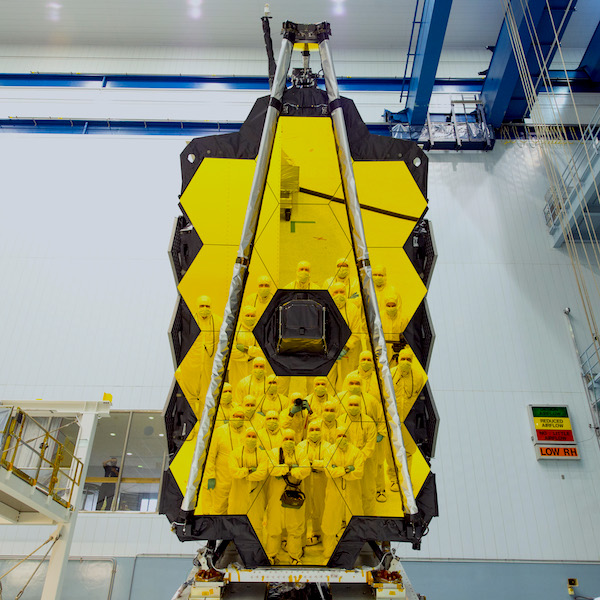
Well, enough about the engineering; sorry to fall into squeeing fan boy mode, there; something I hope I rarely do. Now, to the photos. Let’s go!
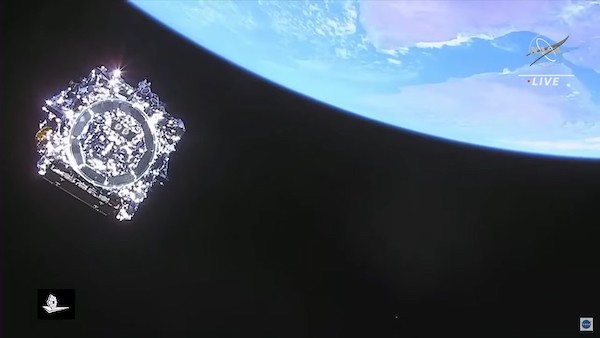
Humanity’s Last Glimpse of the James Webb Space Telescope “Here it is: humanity’s final look at the James Webb Space Telescope as it heads into deep space to answer our biggest questions…. This image was captured by the cameras on board the rocket’s upper stage as the telescope separated from it.”
I think “our biggest questions” may involve how to live on earth. Still, I remember seeing a video of JWST moving away from the upper stage, and being moved by the inevitability of its motion (and also the lovely gold and blue color, not quite captured in this image).
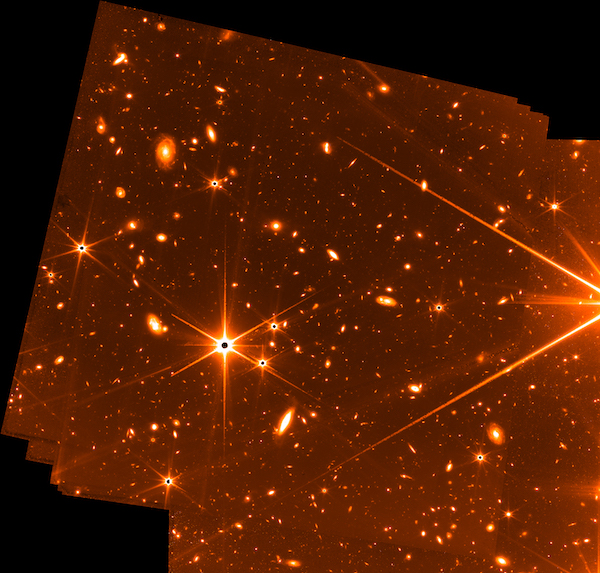
Webb’s Fine Guidance Sensor Provides a Serendipitous Preview “We are one week away from the release of the first science-quality images from NASA’s James Webb Space Telescope, but how does the observatory find, and lock onto its targets? Webb’s Fine Guidance Sensor (FGS) – developed by the Canadian Space Agency was designed with this particular question in mind…. The engineering test image – produced during a thermal stability test in mid-May – has some rough-around-the-edges qualities to it. It was not optimized to be a science observation, rather the data were taken to test how well the telescope could stay locked onto a target, but it does hint at the power of the telescope. It carries a few hallmarks of the views Webb has produced during its postlaunch preparations. Bright stars stand out with their six, long, sharply defined diffraction spikes – an effect due to Webb’s six-sided mirror segments. Beyond the stars – galaxies fill nearly the entire background. The result – using 72 exposures over 32 hours – is among the deepest images of the universe ever taken, according to Webb scientists.”
I like starbursts in photos myself, but this is a different order of things….
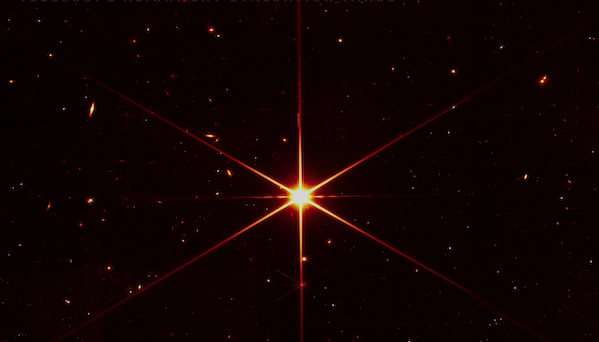
Telescope Alignment Evaluation Image “After completing two more mirror alignment steps, we’ve confirmed the James Webb Space Telescope’s optical performance will be able to meet or exceed the science goals the observatory was built to achieve…. While the purpose of this image was to focus on the bright star at the center for alignment evaluation, Webb’s optics and NIRCam are so sensitive that the galaxies and stars seen in the background show up. At this stage of Webb’s mirror alignment, known as ‘fine phasing,’ each of the [18] primary mirror [hexagonal] segments have been adjusted to produce one unified image of the same star.”
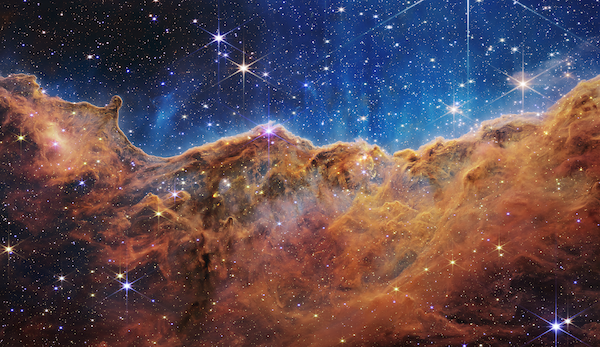
Carina Nebula (birth): “Webb’s new view gives us a rare peek into stars in their earliest, rapid stages of formation. For an individual star, this period only lasts about 50,000 to 100,000 years.”
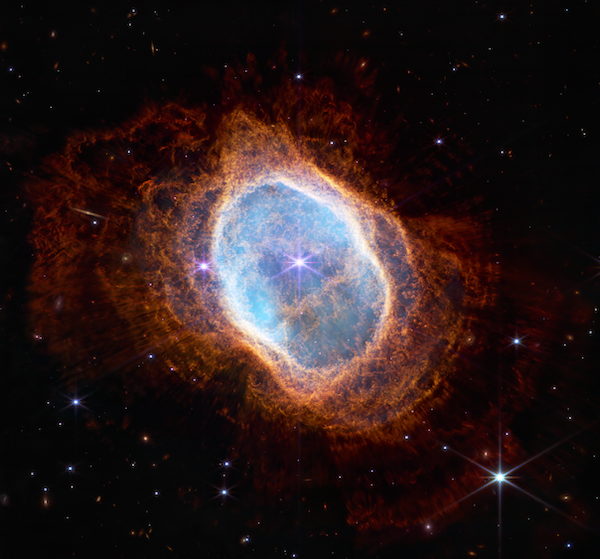
The Southern Ring nebula (death): “[T]hese are shells of dust and gas shed by dying Sun-like stars. The new details from Webb will transform our understanding of how stars evolve and influence their environments.”
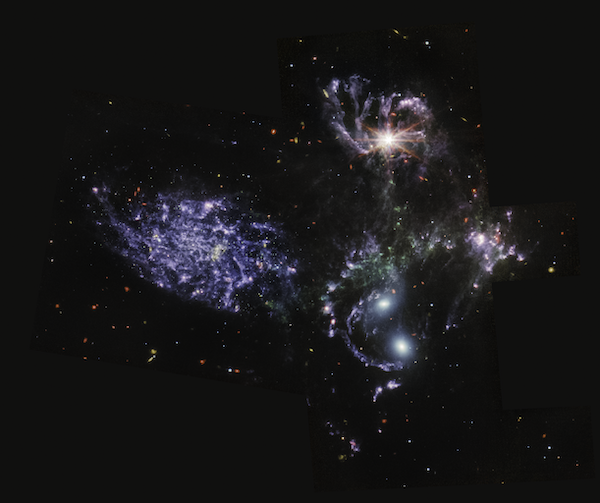
Stephan’s Quintet: “Stephan’s Quintet, a collection of five galaxies, as seen by MIRI on the James Webb Space Telescope. The galaxies all glow in different colors, surrounded by lacy, glowing clouds of gas and dust. Four of the five are centered in the image. Three are visibly spiral galaxies, with tendrils extending out from their glowing centers. The galaxy farthest to the left appears slightly more clearly, with vibrant blue lacing surrounding the oval-shaped light of the galaxy. This is because the farthest left galaxy is not interacting with the other four; it’s actually far in the foreground from the others. The galaxies all appear against a field of sparkling stars and other, farther galaxies.”
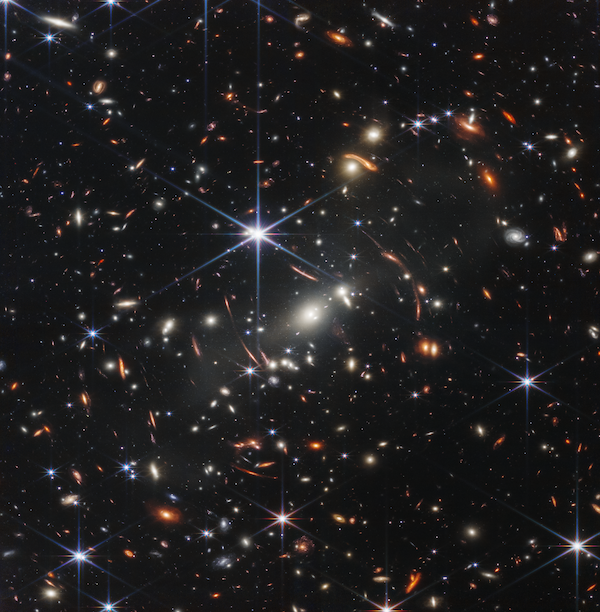
Space (“it’s big”): “[This is] the deepest and sharpest infrared image of the early universe ever taken… Webb was able to capture this image in less than one day, while similar deep field images from Hubble can take multiple weeks…. The background of space is black. Thousands of galaxies appear all across the view. Their shapes and colors vary. Some are various shades of orange, others are white. Most stars appear blue, and are sometimes as large as more distant galaxies that appear next to them.
“Webb was able to capture this image in less than one day.” Big fan of long exposures, depth of field here, but holy moley! No wonder there weren’t more photos!
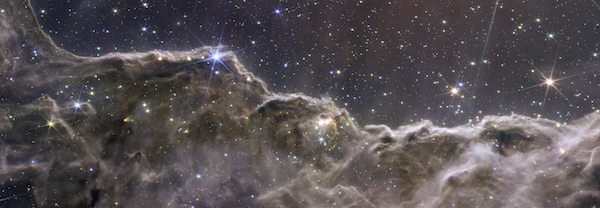
Carina Nebula (once more): “A composite image of the Cosmic Cliffs in the Carina Nebula, created with the Webb telescope’s NIRCam and MIRI instruments. Pinkish brown clouds of gas and dust dominate the foreground of the image, glittering with young stars. Behind the glowing, mountainous clouds, the sky appears navy blue, with shining stars and galaxies.”
Finally, data is important, too:
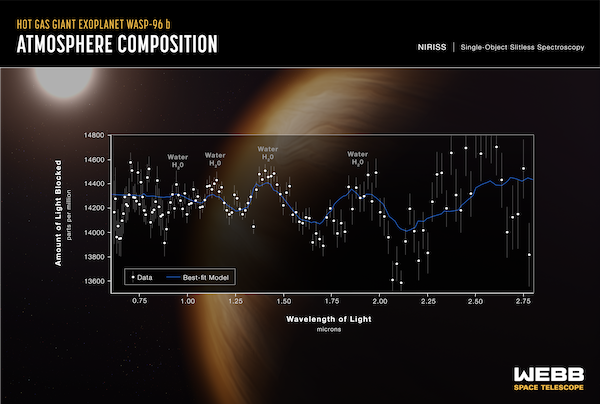
WASP-96 b: “The James Webb Space Telescope spotted the unambiguous signature of water, indications of haze & evidence for clouds (once thought not to exist there). This is the most detailed exoplanet spectrum to date! A spectrum is created when light is split into a rainbow of colors. When Webb observes the light of a star, filtered through the atmosphere of its planet, its spectrographs split up the light into an infrared rainbow. By analyzing that light, scientists can look for the characteristic signatures of specific elements or molecules in the spectrum. Located in the southern-sky constellation Phoenix, WASP-96 b is 1,150 light-years away. It’s a large, hot planet with a “puffy” atmosphere, orbiting very close to its Sun-like star. In fact, its temperature is greater than 1000 degrees F (537 degrees C) — significantly hotter than any planet in our own solar system!”
Very pleased that the WASP planet has water — although perhaps gin with a touch of vermouth would have been more appropriate?
I suppose when the aliens who ended up running our quarantine whizz by the JWST, they scoff: “Mirrors! How charmingly antiquated! I stayed at a B&B on Betelgeuse IV that had one of those.” Nevertheless, I find the success of the JWST as an engineering project re-assuring; we have had no MCAS debacle; no Uber autonomous vehicle scamming; the algos seem pure. Somewhere, out there, there is a stable platform sending home images of staggering beauty, not because beauty was sought, but because it was found.
Of course, as a final note, I should be thinking of public relations, which at NASA, despite the sad episode of the space shuttle, a bad idea badly executed, are not unknown. The New York Times, shockingly, did some actual reporting on how these particular photographs were selected, starting in 2016 (!):
In 2016, a committee of representatives from the Space Telescope Science Institute, NASA and the European and Canadian space agencies convened to start choosing Webb’s very first demo targets. They checked off boxes that vibed with the telescope’s scientific goals: a deeper-than-ever deep field, galaxies pulsing in the void like jellyfish, a star with an attendant exoplanet, star-forming regions like the Carina Nebula and more. Ultimately, this process nominated around 70 possible targets.
Once the telescope had begun operating this winter, they whittled this list down to regions of the sky it could point to within the six-week time limit — plus a few held in reserve, to tease out in the next few months as the telescope’s scientific pursuits cranked into gear.
In early June, for example, Klaus Pontoppidan, the astronomer leading this early release team, was the first human to download the new telescope’s full “deep field” view. This long, probing look at distant galaxies peers further back toward the start of time and the edge of space than any instrument of humanity has ever managed. “I was sitting there, staring at it for two hours, and then desperately, desperately wanting to share it with someone,” he said. “But I couldn’t.”
And then, finally, finally, the earliest results started trickling in through the bottleneck of Dr. Pontoppidan’s computer in early June, his being the only Webb user account granted access in this hush-hush phase of observation. From there, the team digitally combined raw frames into deeper, more polished exposures and then passed them on to image processors for color rendering.
Space exploration is never just about space. Stories matter too. And they’re often told by imagery — whether an above-the-fold print, a slickly produced livestream or a Netflix special. This tradition stretches at least as far back as the 1960s, when none other than James Webb, an early NASA administrator whose name would grace the new telescope, embraced art and visual communication as a key part of justifying the Apollo Program.
“He actually came from the State Department, where he was very well versed in ‘hearts and minds’ campaigns,” said Lois Rosson, a historian of science at the University of Southern California. While Webb was its second-ranking official, the State Department embarked on a purge of gay employees, leading to emphatic calls for NASA to rename the telescope that have gone unheeded.
So, they got me. The cold hands of a PR operation got me (and for all I know, State was Webb’s cover). On the other hand, the images are beautiful (as is the engineering), covering the hearts part. The science is worth doing, covering the minds part. Rembrandt was a businessman, after all. So was Shakespeare. Lincoln was a railroad lawyer. Ah well, nevertheless….


And all publicly funded.
Perhaps we could surreptitiously rebuild the US manufacturing base by doing more of this.
Wait. That might actually work. Please reconsider.
I’m also a believer in the dignity of labor, and that work — which isn’t the same thing as a job — is important. The JWST is important work, work worth doing.
If only the US, and Canada, and many others I’m sure, could put more money, effort, and political “capital” (I hate that word) into this, and snatch it all away from the warmongers who are fueling hate.
By the bye, if it’s ten years late, it must be Putin’s fault. /s
The surest sign that intelligent life exists elsewhere in the universe is that it has never tried to contact us, — Bill Watterston
And because markets.
> Please reconsider.
I guess my thought came across as snark, which was not intended. I had considered adding something like “Mariana Mazzucato would be pleased.” It takes a risk-tolerant entity like a sovereign state to accomplish something like this.
I think we need more of this kind of thing. Given the scale of our real resources expenditure on machines that break things rather than discover things, we have the capacity to do a great deal more of it.
Conservatives will point out that JWST was over a decade late from it’s very first launch date. It works though. A commercial edition of the JWST would have been ready with fewer delays and cheaper but with lots of cut corners after angry fist pounding in the boardroom. Then it would have failed.
I think regardless of government or commercial, as long as you give people who truly want to get the job done the time and resources to do it, they will generally get it done. With the right people we could definitely rebuild the US manufacturing base.
“With the right people we could definitely rebuild the US manufacturing base.”
I don’t believe so, for all I agree with the implied creativity and industry of the population. The material conditions which gave rise to the US manufacturing base in the first instance no longer exist and cannot be replicated. There are paths forward for homo sapiens, but none of them include replication of very much of the 20th century realities most USians grew up within.
> The material conditions which gave rise to the US manufacturing base in the first instance no longer exist and cannot be replicated
Care to expand on that? For example, are you saying we can’t make machine tools?
Here, I suppose, it depends on the “we.”
I think that by “material conditions,” he means are the availability of easily available and cheap petroleum, coal, iron & copper ore, and other raw materials that made the original industrial revolution possible.
By “material conditions,” I suppose he means the cheap and easy-to-obtain fossil fuels and metal ores that were available at the start of the original industrial revolution.
As things are now, the resources needed to sustain an industrial civilization are obtainable only by an already-existing industrial civilization
And all those, lazy, incompetent no-good public employees, don’t forget about them.
The images from the Webb telescope are indeed breathtaking but I am especially hopeful about the potential discoveries scientists might make from study of the images and data the telescope promises.
Considering the origins of the space race — as a military program, Cold-War PR effort, Government R&D program to benefit industry — it seems appropriate to name the Webb telescope for a State Department PR flack brought in for management. In past ages men built their pharaonic projects to the glory of the gods, and later to a God. Today, only military or government funding for Corporate profit seems able muster such projects. There is tragedy in this. These are times that badly need some kind of pharaonic aspiration to inspire Humankind.
Lambert, I can’t tell you how grateful I am for your palate cleansers. Wonderful post. It’s so awesome that America can do something that works.
> I can’t tell you how grateful I am for your palate cleansers
[lambert blushes modestly]
Space exploration and observation (which I hasten to add are not remotely the same as insane plans for space colonization, which is a. almost certainly impossible and is just going to to get a bunch of people killed, and b. not desirable anyway) is an area where the idealist in me comes out.
Space programs have actually always given huge return on investment in terms of innovations, but even if that weren’t the case I would still say they were worth doing, just for the beauty and principle of the thing. We complain a lot here about out-of-touch, overpaid specialists and ivory tower academics, and that loathing is richly deserved. But I would put people like astronomers (who I gather are not remotely overpaid, though I’m sure many wish they were) outside those categories. They’re doing a lot of pure science that is doubtful will ever have much direct impact on human affairs (though something like being able to detect and divert or destroy a planet killing rock would clearly have practical worth), but which is still worth doing if for no another reason than some philosophical commitment to advancing human knowledge. Space programs could cost ten times more than they actually do, and they would still be worth doing (as well as still being a tiny sliver of our annual military spending. The total cost of the James Webb telescope is going to be around 10 billion dollars, which is a freaking rounding error to the Pentagon. We’ve already sent almost six times that to Ukraine for Russia to set on fire).
When you’re looking at any of these pictures (or pictures from Hubble or other older telescopes), but especially the extra-galactic ones, your mind really can’t truly comprehend what it’s looking at. Other than perhaps some of the especially bright spots, which are likely singular stars (relatively) close to the telescope, there are no stars in that Deep Field photo. Every light is an island of at least a billion stars, most of which are now long dead. You actually can’t comprehend the scale, either of physical distance or of time, that you’re looking at. Well, I keep saying ‘you’, but maybe this is a me thing and I’m projecting it onto other people. For me, I can know the numbers and understand it in abstract, but if I actually try to ponder the scales of space my head literally starts to throb. For example, the nearest star to the Sun is a bit over four light-years away. The two Voyager probes, which have have been traveling for almost 50 years at roughly 35,000 miles per hour, have still not traveled a single light-day. The Andromeda Galaxy, which is basically right next door to our Milky Way, is 2.5 million light-years away. And then the scales get almost literally exponentially larger as you zoom further out from there.
And if you care about such things, assume one planet for every star (and the real number of planets is probably far higher than that). Even if life is a vanishingly rare occurrence in the universe, within that one photo we’re probably looking at millions or billions of civilizations, all now long dead.
The evidence suggests that at least one of those millions of civilizations is looking at us, and writing Doctoral thesis about primitive social dynamics.
Search the page for “aliens” and click on the link there.
That is a nice story albeit with a cruel ending.
By the time I got to “Cruel. But you said it yourself, who wants to meet meat?” I was laughing so hard that I had to get a hold on myself.
Travelling at 10 X C, if I’m not mistaken, it would take you 50 million years to go from one end of the Laniakea Supercluster to the other?
Most science fiction doesn’t make intergalactic travel a thing. Even when you cheat and make up some sort of FTL (and there are many different flavors of it throughout fiction), the scales are so large that you still can’t easily have travel between galaxies. Most space scifi stories are still set within just the Milky Way.
The Milky Way alone is so vast that even if we somehow develop practical FTL it would be sometime before we would need to explore the Laniakea Supercluster for any reason beyond it’s there. Also, FTL good for inside the galaxy would not necessarily be enough for outside. A bicycle against a car.
I know those things, Sore and Bird. It was just a demonstration of scale.
26K light yrs to Sagittarius A I think. Get close? I don’t think so. If I calculated correctly one star is revolving around Sag A at 3000 mi/sec (perigee).
Great post, thank you! I have always found it impossible to get my head around the distances involved in that deep space image. In the 80s, National Geographic magazine produced a wonderful poster. It explained the distances involved by first placing the earth in the context of the solar system, then going upwards in scale to our local group of stars, then to our arm of the Milky Way, then to our local group of galaxies, and so on …. until eventually getting to our place in the known universe. I stared at this poster for hours. It never lost its fascination.
I’m specticle. How do they know how far away a given light source is from us.
Standard candles.
And redshift. And parallax, if it’s nearby.
Stunned by the red shift of many galaxies in the deep space pic. And wondering if some or most of the slightly crooked reddish galaxies are thus due to gravity-curved space between there and here.
The elongated (you’ll notice that the elongations are generally in the circumferential direction with respect to the center of the foreground galaxy cluster) and generally redder galaxies are more distant galaxies behind the foreground cluster of galaxies. Light from them is deflected as it travels past the cluster toward us — deflected by the gravity of the cluster or, as you say, by the spacetime curvature induced by the cluster’s mass distribution — and this displaces the perceived position of the background objects from where we would see them if the foreground cluster were not there.
In some cases, there are multiple images of the same background object.
The generic term for this is ‘gravitational lensing’ and lensing by clusters can be spectacular. It’s a useful tool for estimating the distribution of mass in clusters and even sometimes in individual galaxies.
“..the state Department engaged on a purge of gay employees.”
State is always doing this. I imagine that it is also a cover for getting rid of hold overs from previous administrations, ruling ideologies. As for Webb originally being a stealth employee of a Three Letter Agency that shall not be named, hmmm… the rumours about that outfit are of long standing and widespread.
No matter, Webb accomplished a difficult feat; keeping NASA a functioning public agency.
The pictures though are wonderful. Expect a lot of rice bowls in space sciences to be broken by unexpected information coming down.
Thank you for the post and thank heavens for the JWST: THTW- The Thing That Works.
Thanks for writing this. I find this accomplishment and the new possibilities immensely exciting: we get to peer at things that have never before been seen by humans, either very far away or closer but in unprecedented detail. I get a sense of how the early polar explorers or climbers of Everest must have felt.
Deep field images have the ability to convey the bigness of the universe in a very visceral way (these smudges of light are all galaxies; look at how many there are in just a tiny square of sky). I got that same feeling from the original Hubble deep field image. I am sure we will see more analysis of this new one in time, but there appears to be some gravitational lensing captured (the ‘ripples’ around a central object). Or maybe that’s just a rotation artefact from the long exposure? I look forward to finding out.
The atmospheric composition analysis is exciting as well – it’s vastly more detailed than anything we’ve been able to accomplish previously. I think the reason so many known exoplanets are large, hot planets in close orbit is because they’re the easiest ones to detect. But we do know of others, including some ‘Goldilocks zone’ planets. The Holy Grail would be detection of significant atmospheric oxygen (it’s unstable, and only exists in significant quantity on Earth because living beings are constantly producing it) and it looks like the new telescope should be more than capable of finding it if it’s there.
On an aesthetic note, this is the first device I can think of that NASA has produced that looks like it might be at home in a sci fi movie. You have only to look at high performance vehicles and the like to know that there is a kind of beauty associated with highly optimized solutions to intersecting engineering problems, and it’s definitely on display here.
PBS Nova show tonight is about the Webb Telescope.
Description
Explore the dramatic story of NASA’s James Webb Space Telescope-the most ambitious observatory ever launched-through a series of high-stakes milestones, from its conception to completion.
This article gives an explanation for the six “starburst” rays observed in Webb telescope images, and along the way details the meticulous procedures that were used to achieve such sharp images from the complex mirror.
“Where do James Webb’s unique “spikes” come from?”
https://bigthink.com/starts-with-a-bang/james-webb-spikes/
That’s an excellent link. Thanks!
Totally mind blowing when one considers the vastness of the universe. I am a nutter who believes that each speck of light is some form of consciousness much greater than an individual human, as explained in HPB Blavatsky’s Secret Doctrine. According to the Vedas there is a beginning and ending of a universe, called the Days and Nights of Brahma. 311,040 billion human years for both a day and night. Spirit and matter in the cosmic dance of existence.
Look up Pablo Sender, Living Theosophy. Pablo is from Argentina, a microbiologist with a PhD in Biological Sciences. He also can be found on utube with videos explaining Theosophy. It’s time we’ll spent to exercise one’s mind. IMO
I’m a nutter to the extent that…who…Strawson is? (photons & gluons may be sentient) But that’s as far as I’ll go with you. The Galen Strawson issues have been kind of, like, on hold from time to time during the years of my life (neglected). I believe he maintains their consciousness is the fundamental consciousness, and that “sentience” of larger constructs (and/or what many think of as souls) only derives from them (consciousness comes from “the bottom up”). For me, the consciousness of each soul is tacit…just as tacit as that of each photon [I think that agrees with Whitehead in terms of larger constructs though not re souls; while I disagree with Whitehead’s axiom there is no substance, AND disagree with him on the nature/existence of “actual occasions”]. So far, it looks like the thinking of Rupert Sheldrake is more in line with my own. But I’m not shelling out for books that’ll tell me where and how he agrees with Whitehead (he does some).
Same old hard thing to understand. Whatever direction you point the thing…no matter how far it sees…you witness happenings closer to the beginning. In all directions. So, where did the bang happen?!?!
I thought due to overtime I wouldn’t get to read this maybe till Tuesday, but now it looks like there could be some let-up. http://curious.astro.cornell.edu/about-us/102-the-universe/cosmology-and-the-big-bang/the-big-bang/592-can-we-find-the-place-where-the-big-bang-happened-intermediate
This link has photos of the same things from both Hubble and Webb.
https://bigthink.com/starts-with-a-bang/before-and-after-james-webb/
Very nice comparisons with explanation of the differences between the Hubble and Webb telescopes. Thanks.
A very satisfying post this. There is something very fulfilling about great engineering, especially cutting-edge engineering, that can really resonate with a lot of people, myself included. Those engineers sat down, worked out what they wanted to do, what would be necessary to make it work (after a lot of wincing), mustered the people and the resources to execute this multi-year plan and then went ahead and did it. And now and in the years to come, we will be reaping the benefit of all that hard work and dedication. I guess over time I have developed a soft spot for good engineering whether it be a simple walking stick design or even a space telescope and I am reminded of a line from a fictional space show-
‘It may be the warriors who get the glory, but it’s the engineers who build societies. Don’t forget that.’
– Lieutenant B’Elanna Torres, Star Trek Voyager
I suspect the biggest drama it will create, is finding evidence of processes that can no longer be squeezed within the time constraints of the Big Bang Theory. Quite a few have already been detected, but patches have been applied, such as Inflation.
One of the first patches and most egregious, was to use the premise of spacetime to explain that space itself is expanding, rather than these sources are simply moving away in space. This was because redshift increases with distance, so we would have to be at the exact middle of this universe.
The logical incongruence is that if space were to relativistically expand, the speed of light would have to increase proportionally, in order to remain CONSTANT!!!
Two metrics are still being derived from the same intergalactic light. One based on speed and the other on the spectrum. Given the speed is still being implicitly used as the denominator, or it would be a tired light theory, it doesn’t come close to adding up.
The deeper issue is one way that light does redshift over distance, is as “packets,” since the higher frequencies dissipate faster, but that would mean the quantization of light is a function of its absorption and measurement, a “loading” theory, rather than fundamental to the light itself and we are sampling a wave front, not detecting individual photons traveling billions of lightyears. Which really goes against the Canon.
Good Lord, can’t quantum theory anticipate how the shift might appear to be due to a fundamental/sole wave feature…but that the light nevertheless [in a way we can’t discern at the moment] remains both waves and photons?!
What do you mean by “is a function of its absorption”??
Well, this method of detection makes it look like a wave front, but another one later might interpret the phenomena as photons?
Can you clarify “absorption”?
I’m still thinking my question was perhaps better put in a reply prior to this one, but I’m not seeing that it went up.
In their report, they also included two images of Jupiter to prove Webb’s ability to track moving objects-
https://news.sky.com/story/james-webb-space-telescope-team-leaks-two-pictures-of-jupiter-12651084
Very satisfying! Thanks!
And so everybody can have a little of this mighty wonder right in their own home:
Stellarium
http://stellarium.org
Stellarium is a free open source planetarium for your computer. It shows a realistic sky in 3D, just like what you see with the naked eye, binoculars or a telescope.
Please, please, please emphasize that we can see neither the far nor near infrared frequencies of light and so the colors on the images are false colors. Such notices need to be made over and over and over because we cannot assume the readership understands that. (A picture is worth a thousand words.)
I once told a textbook publisher that a caption of “an atom” when what was being portrayed was an artist’s conception of atom was not acceptable. (Also the conception was very, very flawed. It included false colors with no explanation (blue protons and pink neutrons, oh my!) and things were out of scale and misplaced.)
In the third photo from the end, there appears to be some “lensing” from the area centered at the bright white fuzzy light just below and to the right of the bright 6 pointed starburst artifact. Any opinions?
Black holes often cause this.